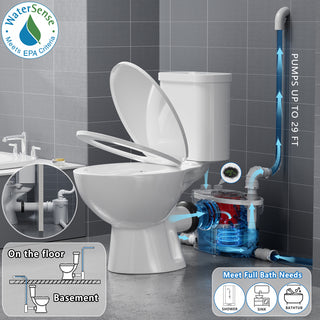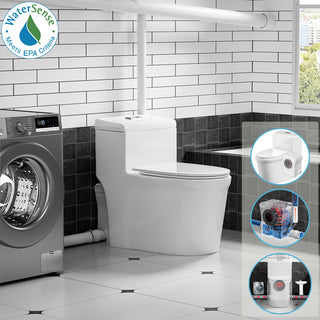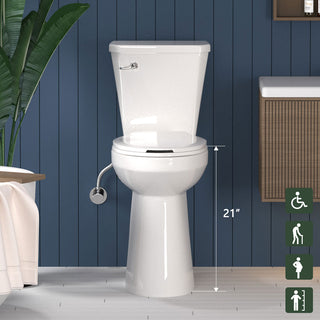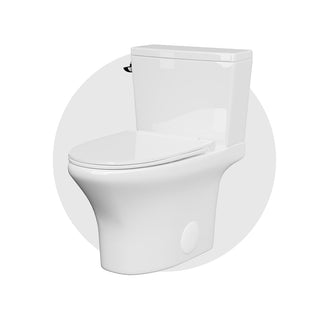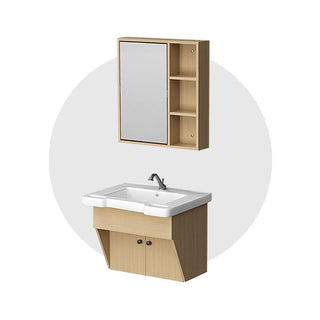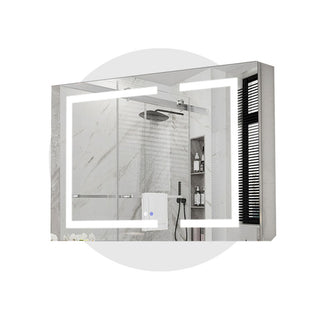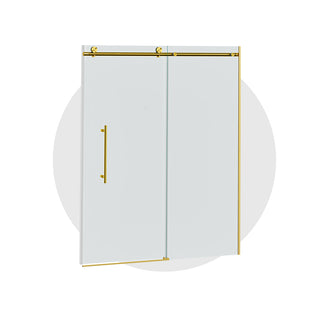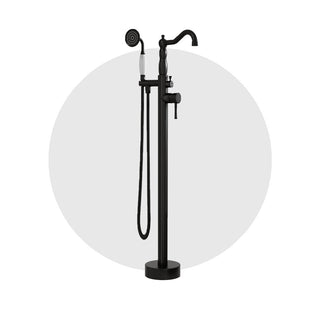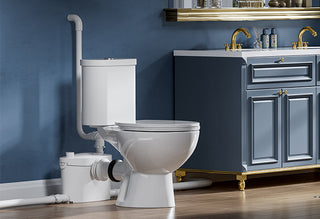When remodeling your home or adding a bathroom, you might come across the term "upflush toilet." So, what exactly is an upflush toilet? Why should you consider it? How is it different from traditional toilets?
In this post, we will answer these questions, helping you understand how upflush toilets work, their pros and cons, and provide you with the information you need to make an informed decision.
1. What is an Upflush Toilet?
In simple terms, an upflush toilet is a type of toilet that uses a high-pressure pump system to "flush" waste upwards. It’s also known as a macerating toilet because it grinds up waste. To make it easier to understand, let’s compare it to a traditional toilet.
1) Different System Structure
Imagine you walk into a bathroom where an upflush toilet is installed. Take a look around (click the video below to explore).
You’ll see that it looks very similar to a traditional toilet at first glance. And that’s true! But if you look carefully, you might spot a white box behind the toilet—that’s the core of the upflush toilet: the macerator pump. We can also see the hidden difference between a traditional rear discharge toilet and an upflush toilet from the side:
We can also see the hidden difference between a traditional rear discharge toilet and an upflush toilet from the side: You can choose to hide the pump behind the toilet, or, for a cleaner look, use an extension pipe to place the pump behind the wall.
You can choose to hide the pump behind the toilet, or, for a cleaner look, use an extension pipe to place the pump behind the wall.
2) Different Working Principle
Traditional toilets rely on gravity to move waste through the pipes. But how does an upflush toilet work? It uses a macerating pump to achieve this.
After flushing, the waste enters the macerating pump, where a floating switch activates the pump. The pump’s impeller starts spinning, using stainless steel blades to quickly chop up solid waste into a slurry. This slurry is then pushed through a small-diameter pipe to a higher point, where it is ultimately discharged into the sewage system or septic tank.
This method overcomes the limitations of traditional gravity-based plumbing, making it ideal for spaces like basements or attics, where gravity drainage isn’t an option.
2. Is an Upflush Toilet Reliable?
To answer this, we need to focus on some key features related to the installation and operation of upflush toilets.
1) Easy Installation
Installing a traditional toilet can be a hassle—breaking through concrete, hiring expensive plumbers, and spending days designing and laying out complex drainage systems. But with an upflush toilet, the process is much simpler. All you need to do is lay small pipes in the existing room layout, place the toilet and pump in the right spots, and you can install it yourself! If you prefer hiring a plumber, it usually takes only a few hours to complete. If you already have the pipes in place, the installation can take as little as 30 minutes—saving you thousands of dollars!
2) Flexibility
The fact that it doesn't rely on traditional drainage systems means you can install an upflush toilet anywhere! You can install it anywhere—basements, under staircases, attics, garages, guest rooms, rental property or even temporary workspace. Whether it’s for a home renovation or a commercial space, it’s a great option.
3) Versatility
Many upflush toilets come with extra inlets, allowing you to connect not just the toilet but also sinks, showers, bathtubs, and even washing machines. You can set up a full bathroom with ease.
4) Long Lifespan
Upflush toilets are equipped with high-quality electric pump systems, and with proper maintenance, they can last over 10 years. They’re durable, and regular cleaning keeps them running efficiently.
Additional Benefits:
- Increase Property Value and Satisfaction:
Adding a bathroom is one of the most effective ways to increase your home’s value, whether you’re selling or renting. According to the Remodeling Impact Report by the NATIONAL ASSOCIATION OF REALTORS®, adding a mid-range bathroom costs about $80,000 on average, with a return on investment (ROI) of around 50%, and homeowner satisfaction scoring 8.2 out of 10. By using an upflush toilet, you can save on the construction cost and enjoy a higher ROI and greater satisfaction.
- Water Conservation:
Toilets account for 24% of a household's daily water usage. Watersense-certified upflush toilets can reduce water consumption by 20%-50% compared to traditional toilets.
3. Are There Any Drawbacks to Upflush Toilets?
While upflush toilets have many advantages, there are a few drawbacks to consider:
1) Higher Initial Cost
Upflush toilets typically cost several hundred dollars more than traditional models. Some premium models can cost over a thousand dollars. However, when compared to the cost of installing complex plumbing systems, the extra expense is often worth it, especially considering the water-saving benefits, sanitation improvements, and ease of installation.
2) Reliance on Power
An upflush toilet needs electricity to power the pump. This means that during a power outage, the toilet may not function properly. However, most modern upflush toilets come with backup systems to ensure that they remain functional during short-term power disruptions.
3) Noise
Because upflush toilets use an electric pump, they can produce some noise when flushing. However, most modern models have optimized the pump for quieter operation, so the noise typically doesn’t interfere with daily use.
4) Regular Maintenance
While upflush toilets have low maintenance costs, the electric pump and mechanical components still need to be inspected and maintained periodically to ensure long-term performance.
4. Frequently Asked Questions
- How long do upflush toilets last?
Answer: Upflush toilets typically last between 10 and 15 years, depending on usage and maintenance. Regularly cleaning the pump system and pipes will extend the lifespan.
- Do upflush toilets Smell?
Answer: Upflush toilets are designed to avoid odor problems. If odors occur, it is usually because the pump system or pipes haven't been cleaned properly. Keeping the system clean and maintaining it regularly will prevent odors.
- Does An Upflush Toilet Need a Vent?
Answer: Many upflush toilets come with carbon filters that don’t require venting. However, some models might need additional venting, especially in tightly sealed spaces. You can add a proper vent system as needed during installation.
- How Loud are Upflush Toilets?
Answer: Modern upflush toilets are much quieter than earlier models. The noise level is generally low and won’t interfere with daily life, but check the specs for noise ratings if you are particularly concerned.
- Do they require electricity?
Answer: Yes, upflush toilets need electricity to power the pump system, but the power consumption is minimal and won't burden your electrical system.
- Can any toilet be converted into an upflush toilet?
Answer: No, only rear discharge toilets can be converted into upflush toilets with the appropriate macerating pump.
- Can an upflush have a shower toilet and sink?
Answer: Yes. Most models of upflush toilet macerator pump are equipped with additional water inlets for shower, sink, bathtub or washing machine.
5. How to Install an Upflush Toilet?
Installing an upflush toilet is relatively straightforward. Here are the basic steps:
- Choose the Right Model: Select an upflush toilet based on your installation space and needs.
- Set up the Pipes and Power: Lay out the drainpipes and power lines, ensuring the electrical connections are correct.
- Install the Toilet: Position the toilet in its designated spot and connect it to the drain pipes.
- Connect the Pump System: Connect the macerating pump to the plumbing and ensure smooth drainage.
If you’re not familiar with plumbing and electrical work, consider hiring a professional plumber to assist. But for most homeowners, following the manufacturer’s instructions will make installation manageable. If you're interested, click here to see How to Install a Macerating Toilet.
6. Best Upflush Toilet Brands
Saniflo and Liberty Pumps are two of the most well-known upflush toilet brands, particularly their Sanibest Pro, Sanibest Plus, and Ascent II models. While they’re highly reliable, their prices range from $800 to $1500.
If you’re looking for a budget-friendly option, consider the Simple Project SNFLEX Macerating Toilet. While it’s a newer brand, it’s earned a reputation for offering excellent value at around $700, often with extra discounts. With its efficient maceration and drainage system, SNFLEX stands out as a great alternative to pricier brands like Saniflo and Liberty Pumps, making it an excellent choice for first-time buyers on a budget.
Conclusion
I sincerely hope this post helps clarify all your doubts about upflush toilets. Got questions or new ideas you’d like to discuss? Drop a comment below—I’m happy to help!


